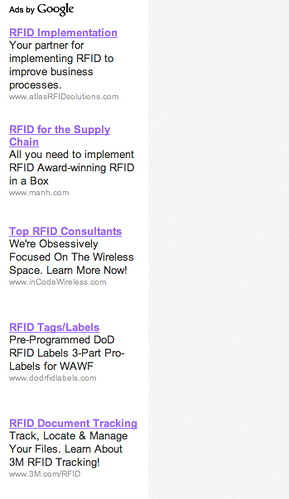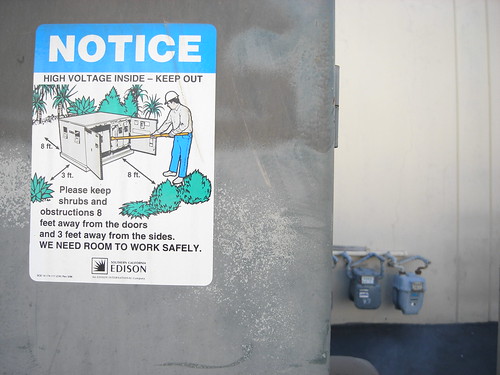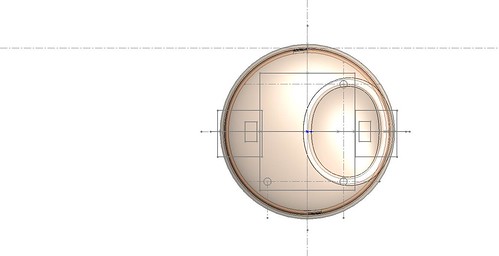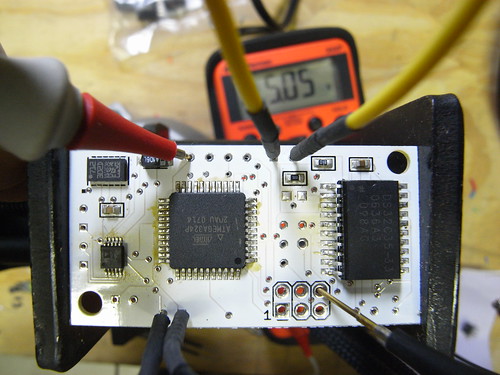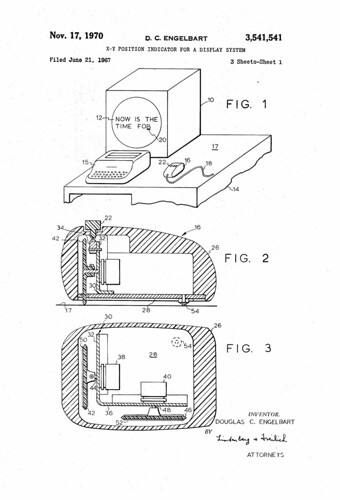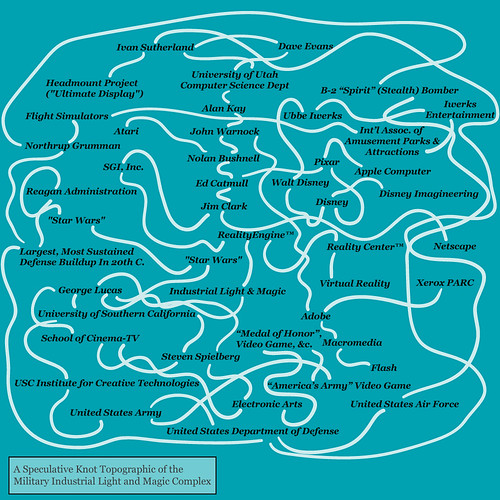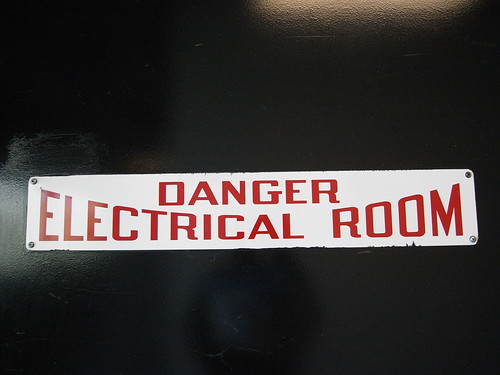Ack. This is one that drives me a little batty. Technology — friend or foe? Well, neither, of course. It’s how the technology is used that determines its normative dimensions. Right?
Pfft.
Even in the world of clever, insightful, creative art-technology, you get practitioners saying things like this about RFID.
I’m not any more optimistic or worried about RFID than any other technology out there. Humans are capable of great kindness and cruelty. That is independent of any technology.
(From Regine’s interview with Doria Fan about her quite nice RFID-based objects. The full interview is here: http://www.we-make-money-not-art.com/archives/2008/03/rfid-workshop-at-imal-in.php)
Why are such binaries even erected? They end up diminishing the fact that “technology” is a human endeavor always. It is no more independent of “humans” or social practice than anything else in the world that gets given meaning in our own terms. Is it just a technology without any human participation? Did it just up an appear in the world like an anonymous fart in the wind? Can you really be no more optimisitic or worried than anything that actually moved you to create? C’mon..get a hold of yourself.
Run the list. Nature? Did it just appear? Nothing that pre-exists us, despite what the atavists would like to believe. It’s entirely constituted and given meaning through our construction of knowledge about it (“science”); through the desire to relate, offset, contrast, etc. ourselves and our lives to it (“things would be better/worse if we ‘returned’ to nature”). And so on.
One consequence of believing that technology is independent of human social practice is that you loose track of the story about who is creating these things, for what purpose and with what consequence to their ability to shape and remake the world. If you don’t tell that story, you have not done your work. You don’t share credit with who is effectively your collaborators. You can no longer ignore their influence on your work than you could ignore the way your peers and mentors shape and make what you do possible. The story does not need to be an indictment, but it is a story without which the work done would not be possible.
Another consequences of believing that technology is independent of human social practice is that you loose your seat at the design table. You end up waiting for someone else (or some weird, independent machine that contains no humans, no beliefs, no ideologies and no selfish or selfless aspirations) to create things that you’ll then complain about, or accept blindly or love.
Technology? How can it be seen as something independent of the practice of humans? Did, say, RFID drop out of the sky one day? No. A bunch of very smart people got together and starting fussing with an idea they had. And they materialized it. They enrolled a bounty of powerful players in various industries and political lobbies and so forth to make it bigger than life. They talked to lots of people in manufacturing to try and figure out how to make millions and millions of various kinds of RFID tags, and detectors. They worked through standards for construction and allocation of identification codes, etc. People wrote books — technical books, trade books, warning books, instructional books.
How is this independent of human capabilities to do great kindness or great cruelty?
The greatest possible damage that can be done vis-a-vis technology and making more habitable, sustainable worlds is to imagine that technology is independent of human capabilities to do good or bad things. To say that technologies are value neutral and then say that it is how we use that particular technology misses the strongest possible case for justifying the occasionally provocative linking of art with technology. That is, to show how our things can be other than they are.
To disrupt the assumption that technologies are not made from often complex social-political-ideological-financial assemblages of the human kind. They may seem “trans-human” — as in a complex web of ideas, politics, money, far-flung manufacturing empires, overwhelmingly enormous projects, powerful financial enterprises all out of proportion to individual humans. But you cannot ever trace this without finding individual humans. Whether the gal on the factory floor hand-assembling some part that machines cannot. Or a venture capitalist in his fancy Freedom chair deciding whether it’ll be go or no-go for a new endeavor. These decisions and practices and hand-work are done for reasons and reasons are backed by normative assessments — what is this “thing” good for?
The disruptor — the art-technology creative, sometimes — is able to untangle what has been knotted together into a specific purpose. Perhaps we should call this person the denoer. The person who untangles knotty assemblages. It can be easier or hard to do the unknotting. Look at the edges and the fraying end-points, like this Google Advertisement. It shows pretty clearly who is participating and for what reason.
This is why “we” lobby for open instrumentalities, open-source, open-APIs, legible toolkits/communities. It’s so that the knot of influences that shape devices for particular purposes can be re-tied to say something else. And this process is much more about retying, about constituting a specific and perhaps different assemblage that is constituted based on a different set of normative goals.
But, the technology was never independent. RFID didn’t just grow from the ground. When you believe that, you loose the deep, human influences and political complexities that are latent within such things. You also loose track of all the problematic implications of new materialized ideas. You give up the possibility of changing or influencing what empires of human will do in fact create such things as RFID, and influencing them in a normative way — that is, influencing them to make things that do not scare you.
Art-technology is not only for the gallery. In fact, the gallery is no more than the first step in the influence creative practices should have in the endeavor of creating new feature sets for the worlds we occupy. Galleries are like Class 1 clean rooms for new ideas. These ideas should materialize in more rugged, designed form that purposely leak out into the world. Shame on the creative technologist who assumes their end-goal should be a gallery show. They should be aspiring to shape their ideas into something that influences or even creates a new enterprise that turns their ideas into world-changing/world-shaping designs that shape and influence and create more habitable, playful, sustainable worlds. Otherwise, it’s all empty ego.
Don’t ever fool yourself into thinking that technology is not synonymous and deeply, inextricably imbricated with the social practice. Ever. You give up everything.
Continue reading Technologies of Kindness and Cruelty
